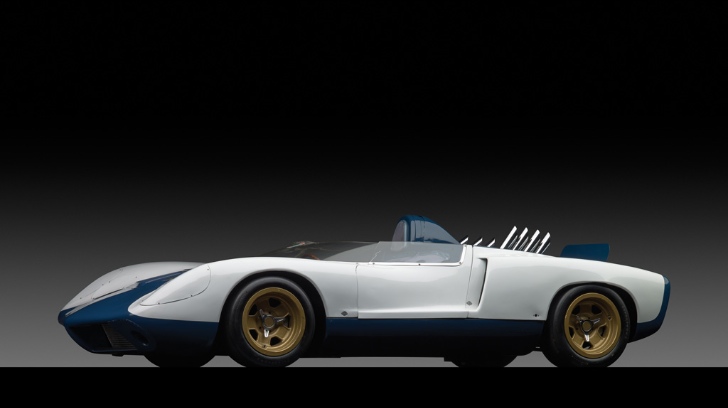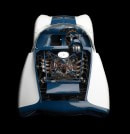As part of a very special 50th Anniversary Corvette Display, the CERV II Experimental Corvette will once again make its way to the Carlisle PA Fairgrounds, where it'll once again be all the rage among Corvette enthusiasts. A car unlike any other before it, the mid-engined racer named Chevrolet Engineering Research Vehicle II will most certainly be the star of this year's Corvettes at Carlisle.
Chevrolet has built a lot of experimental cars during the golden age of American sports cars also known as the 1960's, but the CERV II is the one to remember. The man regarded as "the father of the Corvette", Zora-Arkus Duntov, is a figure most 'Vette fans would know. He's the guy that first put a V8 engine in a production Corvette and the mastermind behind the 1964 Chevrolet Engineering Research Vehicle II.
As opposed to its production counterpart, the CERV II Experimental Corvette has exotic features for a muscle car, such as a mid-engined 377-cubic inch (6.2-liter) small block V8 with 550 horsepower on tap and a four-wheel drive system with dual torque converters to vary the power to the front and rear wheels based on the vehicle’s speed. Responsible for the great aerodynamic bodywork are Larry Shinoda and Tony Lapine. The car weighs a mere 1,848 pounds thanks to the light-weight materials used, such as fiberglass, titanium and magnesium. The experimental racer was capable of 212 mph and a 0-60 mph time of 4 seconds with high-speed gears or a scarcely believable 2.8 seconds with sprint-gearing.
So why did Zora ultimately build the CERV II? Well, he believed that Chevrolet needed a serious machine in order to compete with Ferrari's 248 SP and Ford's GT40 in endurance racing. However, General Motors adopted a no-racing policy early in 1964, at the time the CERV II project was approaching its finishing stage. That's why the car became a full-time R&D vehicle for future exotic Corvette ideas. For example, Chevrolet engineers tested a 700 horsepower 427-cubic inch (7.0-liter) ZL1 V8 on this chassis in 1969, after which they refitted the old small block back.
GM oficially retired the CERV II in the 70's, donating it to the Briggs Cunnigham Automotive Museum in Costa Mesa, California. When the museum closed in 1986, noted collector Miles Collier acquired the collection, eventually selling it to noted car collector John Moores. Mr. Moores eventually chose to donate the car to the Scripps Research Institute, from which it was sold again in 2001. The last time it changed hands, this piece of Chevy history was expected to fetch anywhere between $1.4 and $1.8 million at RM Auction’s Art of the Automobile in Novermber 2013. The winning bidder paid $1.000.000 (roughly €726.274) for the CERV II, excluding buyer's premium.
This year's Corvettes at Carlisle will kickstart on August 22nd and will feature more than 5.000 Corvettes representing all generations of the American classic sports car.
As opposed to its production counterpart, the CERV II Experimental Corvette has exotic features for a muscle car, such as a mid-engined 377-cubic inch (6.2-liter) small block V8 with 550 horsepower on tap and a four-wheel drive system with dual torque converters to vary the power to the front and rear wheels based on the vehicle’s speed. Responsible for the great aerodynamic bodywork are Larry Shinoda and Tony Lapine. The car weighs a mere 1,848 pounds thanks to the light-weight materials used, such as fiberglass, titanium and magnesium. The experimental racer was capable of 212 mph and a 0-60 mph time of 4 seconds with high-speed gears or a scarcely believable 2.8 seconds with sprint-gearing.
So why did Zora ultimately build the CERV II? Well, he believed that Chevrolet needed a serious machine in order to compete with Ferrari's 248 SP and Ford's GT40 in endurance racing. However, General Motors adopted a no-racing policy early in 1964, at the time the CERV II project was approaching its finishing stage. That's why the car became a full-time R&D vehicle for future exotic Corvette ideas. For example, Chevrolet engineers tested a 700 horsepower 427-cubic inch (7.0-liter) ZL1 V8 on this chassis in 1969, after which they refitted the old small block back.
GM oficially retired the CERV II in the 70's, donating it to the Briggs Cunnigham Automotive Museum in Costa Mesa, California. When the museum closed in 1986, noted collector Miles Collier acquired the collection, eventually selling it to noted car collector John Moores. Mr. Moores eventually chose to donate the car to the Scripps Research Institute, from which it was sold again in 2001. The last time it changed hands, this piece of Chevy history was expected to fetch anywhere between $1.4 and $1.8 million at RM Auction’s Art of the Automobile in Novermber 2013. The winning bidder paid $1.000.000 (roughly €726.274) for the CERV II, excluding buyer's premium.
This year's Corvettes at Carlisle will kickstart on August 22nd and will feature more than 5.000 Corvettes representing all generations of the American classic sports car.











